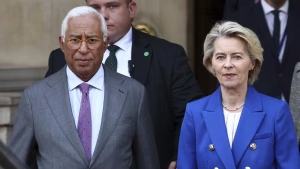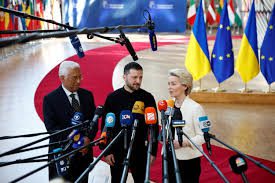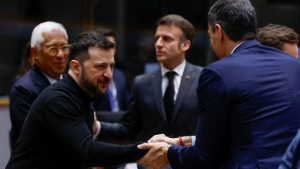On 23 October 2025, the European Council adopted key European defence & security conclusions, jointly with the formal adoption of the EU’s 19th sanctions package against Russia (and Belarus) for actions in Ukraine. These twin developments mark a clear signal of the Union’s intensified strategic posture: ramping up readiness, reducing strategic dependencies, strengthening border defence and emphasising dual-use assets. In depth, this article explores the European defence & security conclusions, the sanctions package, how they interlink and the implications for the EU’s future security. Also Read: European defence & security conclusions.
Also Read: European defence & security conclusions.
Other: Tamil Nadu Weather Update
European defence & security conclusions: strategic priorities
In its conclusions, the European Council emphasised four major priorities: increasing readiness, reducing strategic dependencies, strengthening border defences and enhancing dual-use assets.
First, readiness is assessed via the call for an annual defence readiness report, prepared by the European Defence Agency (EDA) and the Commission. Second, the conclusions focus on reducing strategic dependencies by mobilising joint investment, production and procurement across the EU defence industry, particularly for small and mid-cap firms. Third, border defence is framed as a critical dimension in light of hybrid threats and eastern-flank vulnerabilities. Fourth, dual-use assets and innovation are emphasised as necessary to transform Europe’s defence industrial base for disruptive technologies.
Through these steps, the European Council aims to build a coherent “European defence & security conclusions” agenda that strengthens the Union’s resilience and autonomy.
Defence-industrial mobilisation & procurement
The European defence & security conclusions place particular emphasis on boosting the defence industry via joint development and procurement. Member States are urged to gear investment towards common projects, use economies of scale, standardised requirements and support SMEs and mid-caps.
The EDA is to be strengthened to play a full role in capability development, research and acquisition, with a report due by the end of 2025 on the required measures. This means the European defence & security conclusions are not merely declaratory but pressed into implementation mechanisms. Funding options are being reviewed, the European Investment Bank (EIB) is encouraged to simplify and accelerate support for defence-security companies, and innovation is targeted through a roadmap for industrial transformation.
In short, the “European defence & security conclusions” set the framework for a more integrated, strategically-oriented defence industry across the EU.
Readiness and capability gaps
The European defence & security conclusions also address readiness in terms of capability gaps, mobilising joint initiatives and ensuring oversight. Member States are tasked with normalising annual readiness reporting and coordinating through CARD (Coordinated Annual Review on Defence).
The conclusions recall the existential challenge posed by the war in Ukraine and the need to prepare for future threats. They stress that a stronger and more capable EU in security and defence will contribute to global and transatlantic security, with NATO being reaffirmed.
Thus, the “European defence & security conclusions” signal a step change: moving from planning to implementation, closing capability gaps and strengthening resilience.


Strategic dependencies and dual-use assets
Another core element of the European defence & security conclusions is reducing strategic dependencies—particularly in supply chains, dual-use technologies and defence-critical infrastructure. The Council calls for full mobilisation of the SAFE and EDIP instruments (defence investment, defence industrial policy) to this end.
Cross-border access to supply chains is emphasised, with an aim to integrate SMEs and mid-caps into a pan-European ecosystem. The dual-use element means that technologies which serve both civilian and military uses—such as drones, advanced electronics, cyber and space systems—are at the heart of the new strategy. By doing so, the European defence & security conclusions pave the way for a technologically advanced, interdependent but resilient industry.
In sum, the “European defence & security conclusions” address more than military hardware—they reflect the full spectrum of strategic supply, innovation and industrial autonomy.
The 19th sanctions package: scope and significance
On the same day, the EU adopted its 19th sanctions package against Russia (and Belarus)—a move that underpins the strategic context of the European defence & security conclusions.
The package comprises 69 new individual listings and sweeping economic restrictive measures targeting Russian energy, finance, military-industrial sectors, banks, crypto exchanges and third-country intermediaries, including entities in China and India. It also includes additional measures on Belarus for its support of Russia’s war effort.
Most notably, the package introduces a ban on imports of Russian liquefied natural gas (LNG) into the EU: short-term contracts to end within six months, long-term contracts ceasing from 1 January 2027.
In addition, the “shadow fleet” of Russian tankers is further sanctioned: 117 more vessels added, bringing the total to 557 designations, creating more pressure on Russian export revenues. The movement of Russian diplomats is curtailed via new travel restrictions across the EU.
Therefore, the sanctions package shows how the European defence & security conclusions are embedded in a broader strategic effort to deny Russia revenue, degrade its war economy and reduce Europe’s dependency.
Interlinking defence strategy and sanctions
By aligning the European defence & security conclusions with the sanctions package, the EU demonstrates a comprehensive approach: strengthening internal defence posture while externally denying the aggression-perpetrator (Russia) the means to fuel its war. The readiness, industry, dual-use and border-defence priorities are informed by the threats arising from Russia’s war in Ukraine and hybrid threats emanating from the east.
The sanctions assist the strategic aim of reducing dependencies: energy imports, supply-chain vulnerabilities and third-country enabling of the Russian economy. Meanwhile, the defence posture built under the European defence & security conclusions aims to reduce Europe’s strategic exposure and strengthen resilience.
In short, the policy package is coherent: the European defence & security conclusions and the 19th sanctions package are two halves of the same response—internal preparedness and external pressure.


Going forward, the European defence & security conclusions will require sustained implementation: Member States must invest jointly, strengthen the EDA, participate in capability-building, streamline procurement and support innovation. The annual readiness report will monitor progress. Funding mechanisms (such as via the EIB) must be operationalised.
On the sanctions front, enforcement will be crucial: the LNG ban phases, the shadow fleet sanctions, intermediary designations and diplomatic movement restrictions all require rigorous follow-through. Moreover, monitoring third-country enabling of Russia’s economy remains vital.
For the EU, this dual track means overcoming internal fragmentation—member states must align defence industrial strategy and budgetary commitments—and executing external policy with speed and precision. The European defence & security conclusions serve as a blueprint, and the sanctions package reminds us that strategic autonomy and external pressure are intertwined.
Finally, this marks a moment of heightened ambition: it shows that European leaders view defence, security and economic tools as part of the same strategic fabric. The European defence & security conclusions set the internal agenda; the sanctions package sets the external pressure. Together, they reflect a new chapter in the EU’s response to Russia’s aggression and the need for stronger European security.
 On 23 October 2025, the European Union adopted its European defence & security conclusions and simultaneously rolled out the 19th sanctions package against Russia (and Belarus). The conclusions emphasise readiness, strategic dependency reduction, border defence and dual-use assets; the sanctions target Russian energy, finance, shadow-fleet logistics, and diplomatic mobility. Together they embody a strategic shift in Europe’s posture: enhancing resilience from within while denying aggressors the means to attack. As implementation begins, the effectiveness of both tracks will shape Europe’s security environment for years to come.
On 23 October 2025, the European Union adopted its European defence & security conclusions and simultaneously rolled out the 19th sanctions package against Russia (and Belarus). The conclusions emphasise readiness, strategic dependency reduction, border defence and dual-use assets; the sanctions target Russian energy, finance, shadow-fleet logistics, and diplomatic mobility. Together they embody a strategic shift in Europe’s posture: enhancing resilience from within while denying aggressors the means to attack. As implementation begins, the effectiveness of both tracks will shape Europe’s security environment for years to come.

